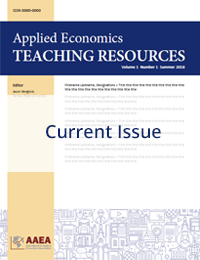Research Article
How Do Students Allocate Their Time? An Application of Prospect Theory to Trade offs between Time Spent to Improve GPA Versus Time Spent on Other Activities
Brian K. Coffey(a), Andrew Barkley(a), Glynn T. Tonsor(a) and Jesse B. Tack(a)
(a)Kansas State University
JEL Codes: A22, I15, O12, O13, Q56
Keywords: Teaching and learning, prospect theory, choice experiment, university students
First Published Online: July 8, 2020
Volume 2, Issue 3
Abstract
We employ a choice experiment survey to elicit university students’ preferences for grade point average (GPA) relative to time spent on various activities. Using expected utility and prospect theory approaches to analyze those preferences, we find statistically significant asymmetry between the desire to increase GPA and the desire to avoid a decrease in GPA. Surveyed students were loss averse regarding GPA: they would trade approximately 4.6 times as much free time to avoid losing a point in their semester GPA relative to time they are willing to give up to gain one additional point. This study contributes to the growing research regarding prospect theory by analyzing loss aversion in a novel context of students’ time allocation.
References
Abdellaoui, M., H. Bleichrodt, and C. Paraschiv. 2007. “Loss Aversion Under Prospect Theory: A Parameter-Free Measurement.” Management Science 53(10):1659–1674.
Adamowicz, W., P. Boxall, M. Williams, and J. Louviere. 1998. “Stated Preference Approaches for Measuring Passive Use Values: Choice Experiments and Contingent Valuation.” American Journal of Agricultural Economics 80(1):64–75.
Ballard, J.S. 2014. “Working for the Weekend: A Time Allocation Model for Student Workers.” Journal for Economic Educators 14(1):108–119.
Becker, G.S. 1965. “A Theory of the Allocation of Time.” The Economic Journal 75(299):493–517.
Ben-Akiva, M.E., and S.R. Lerman. 1985. Discrete Choice Analysis: Theory and Application to Travel Demand. MIT Press.
Bratti, M., and S. Staffolani. 2013. “Student Time Allocation and Educational Production Functions.” Annals of Economics and Statistics (111/112):103–140.
Caputo, V., J.L. Lusk, and R.M. Nayga Jr. 2019. “Am I Getting a Good Deal? Reference-Dependent Decision Making When the Reference Price Is Uncertain.” American Journal of Agricultural Economics. https://doi.org/10.1093/ajae/aaz042.
Champ, P.A., K.J. Boyle, and T.C. Brown, eds. 2017. A Primer on Nonmarket Valuation. Dordrecht: Springer Netherlands. https://doi.org/10.1007/978-94-007-7104-8_1.
Devadoss, S., and J. Foltz. 1996. “Evaluation of Factors Influencing Student Class Attendance and Performance.” American Journal of Agricultural Economics 78(3):499–507.
Kelley, A.C. 1975. “The Student as a Utility Maximizer.” The Journal of Economic Education 6(2):82–92. Koch, A., J. Nafziger, and H.S. Nielsen. 2015. “Behavioral Economics of Education.” Journal of Economic Behavior & Organization 115:3–17.
Krohn, G.A., and C.M. O’Connor. 2005. “Student Effort and Performance over the Semester.” The Journal of Economic Education 36(1):3–28.
Lusk, J.L., and D. Hudson. 2004. “Willingness-to-Pay Estimates and Their Relevance to Agribusiness Decision Making.” Review of Agricultural Economics 26(2):152–169.
Lusk, J.L., J. Roosen, and J.A. Fox. 2003. “Demand for Beef from Cattle Administered Growth Hormones or Fed Genetically Modified Corn: A Comparison of Consumers in France, Germany, the United Kingdom, and the United States.” American Journal of Agricultural Economics 85(1):16–29.
Romer, D. 1993. “Do Students Go to Class? Should They?” The Journal of Economic Perspectives 7(3):167–174. Schmidt, R.M. 1983. “Who Maximizes What? A Study in Student Time Allocation.” The American Economic Review 73(2):23– 28.
Schulz, L.L., and G.T. Tonsor. 2010. “Cow-Calf Producer Preferences for Voluntary Traceability Systems.” Journal of Agricultural Economics 61(1):138–162.
Simonsohn, U. 2010. “Weather to Go to College.” The Economic Journal 120(543):270–280.
Tonsor, G.T. 2018. “Producer Decision Making under Uncertainty: Role of Past Experiences and Question Framing.” American Journal of Agricultural Economics 100(4):1120–1135.
Tonsor, G.T., T.C. Schroeder, and J.L. Lusk. 2013. “Consumer Valuation of Alternative Meat Origin Labels.” Journal of Agricultural Economics 64(3):676–692.
Tversky, A., and D. Kahneman. 1992. “Advances in Prospect Theory: Cumulative Representation of Uncertainty.” Journal of Risk and Uncertainty 5(4):297–323.
Articles in this issue
How Do Students Allocate Their Time? An Application of Prospect Theory to Trade offs between Time Spent to Improve GPA Versus Time Spent on Other Activities
Brian K. Coffey, Andrew Barkley, Glynn T. Tonsor and Jesse B. Tack
Enhancing Student Engagement in a Changing Academic Environment-Tested Innovations for Traditional Classes and Online Teaching
Kristin Kiesel, Na Zuo, Zoë T. Plakias, Luis M. Peña-Lévano, Andrew Barkley, Katherine Lacy, Erik
Gold in Them Tha-R Hills: A Review of R Packages for Exploratory Data Analysis
Kota Minegishi and Taro Mieno
Interacting with Agricultural Policy 280 Characters at a Time: Twitter in the Classroom
Julianne Treme
Making Business Statistics Come Alive: Incorporating Field Trial Data from a Cookstove Study into the Classroom
Andrew M. Simons
Convenient Economics: The Incorporation and Implications of Convenience in Market Equilibrium Analysis
George Davis


